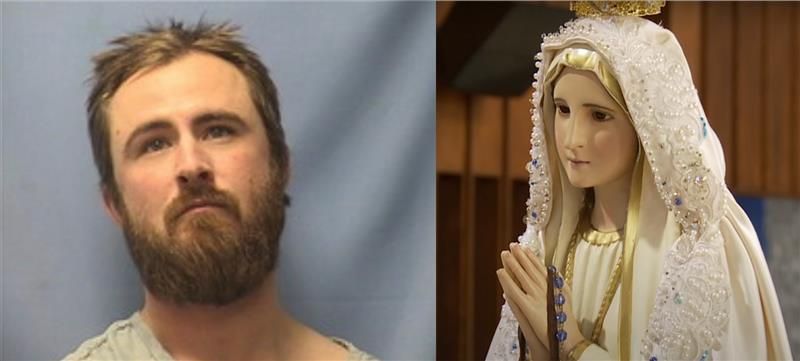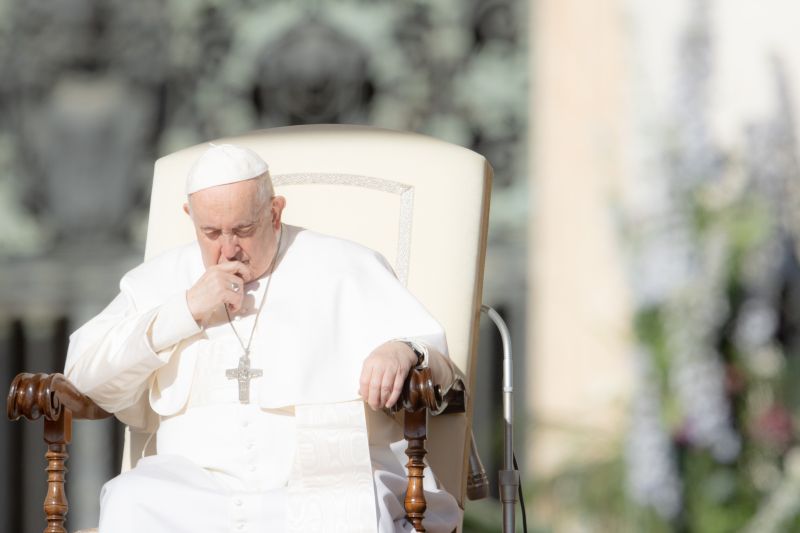 Jerrid Farnam, 32, has been charged with several felonies in connection with a violent vandalism at Subiaco Abbey in Subiaco, Arkansas, on Jan. 5, 2023. He said he was about to begin breaking open the tabernacle where the consecrated bread is kept, but something stopped him in his tracks: a statue of the Virgin Mary. / Credit: Logan County Sheriff’s Office / Suzanne Stratford YouTube screen shot
Jerrid Farnam, 32, has been charged with several felonies in connection with a violent vandalism at Subiaco Abbey in Subiaco, Arkansas, on Jan. 5, 2023. He said he was about to begin breaking open the tabernacle where the consecrated bread is kept, but something stopped him in his tracks: a statue of the Virgin Mary. / Credit: Logan County Sheriff’s Office / Suzanne Stratford YouTube screen shot
Boston, Mass., Feb 6, 2023 / 13:55 pm (CNA).
In early January, a man entered a Benedictine monastery in Arkansas and began smashing the altar with a sledgehammer.
He was about to begin breaking open the tabernacle where the consecrated bread is kept, but something stopped him in his tracks: a statue of the Virgin Mary.
Jerrid Farnam, 32, of Sallisaw, Oklahoma, was arrested for the crimes of property damage and theft committed at Subiaco Abbey in Subiaco, Arkansas, and is currently incarcerated awaiting trial.
Sheriff Jason Massey of the Logan County Sheriff’s Office told CNA that when they brought the suspect in he confessed to the crime. But, Farnam told the police, after he looked up and saw a statue of Mary, he couldn’t continue to break open the tabernacle as he had planned to do.
“He decided he just couldn’t do it,” Massey said. “I think he felt it was wrong at that point.”
Subiaco Abbey had reported that on Jan. 5, a man using “a regular hammer and sledgehammer/axe” began destroying the abbey’s marble altar by smashing it in different places. Founded in 1878, Subiaco is home to a community of 39 Benedictine monks.
The suspect left a gaping hole in the top of the altar and broke open stones that contain relics, the abbey said. Two reliquaries — small, brass-colored boxes that each contained three relics of saints from more than 1,500 years ago — were stolen, according to the Logan County Sheriff’s Office.
Father Elijah Owens, OSB, the abbot of the monastery, told CNA in January that the relics contained in one of the reliquaries were those of St. Boniface, St. Tiberius, and St. Benedict of Nursia.
The other reliquary contained the relics of St. Tiberius, St. Marcellus, and St. Justina, Owens said.
A video of the damage can be seen below.
The abbey said in its press release that the man approached the tabernacle and removed a cross located on top as well as the tabernacle’s veil before being “interrupted.”
Farnam was arrested the same day and three of the relics were found in his truck.
At the time, the reliquary containing the relics of St. Tiberius, St. Marcellus, and St. Justina was still missing. The sheriff’s office later discovered them in a trash can in Farnam’s father’s house.
Farnam gave the reliquary to his father, who, unaware of the nature of the objects, threw the contents of the container in the trash, while keeping the container for himself, the sheriff said.
“Luckily there was no food or anything on them. They were found in great condition,” he added.
Massey said that one of the seven offenses Farnam was charged with was theft of property, a Class B felony, which is the highest classification of a felony in the state, he said.
“You can’t put a price on those relics. They’re 1,500 years old,” he said.
Farnam thought that Jesus’ bones were in the altar and that God was telling him to remove the bones, Massey told CNA. He added that Farnam has a history of substance abuse and was intoxicated during his arrest.
The abbey is under repairs, and a portable altar will now be used until repairs are made, according to the abbey’s press release.
[…]






We read: Pope Francis encouraged members of ecclesial groups to ‘remain in harmony with the Church, since harmony is a gift of the Holy Spirit.’” YES, “harmony with the Church…” But also been thinkin’ ’bout the Holy Spirit and the polyglot Synodal Casserole!
The Vatican keyed its external and provisional agreement with China to the example of “patience” lifted from former Secretary of State Cardinal Casaroli (instructive coincidence of terms, this!). https://www.pillarcatholic.com/p/pope-francis-said-cardinal-casaroli-is-his-diplomatic-model-so-who-was-cardinal-casaroli
Two straight questions, plus an x-ray of shallow-dish Synodal Casserole:
QUESTION: Are we to expect the Synodal Casserole to have the same flat flavor as the transplanted policy of “patience” from Casaroli in Eastern Europe, and now the sinicized Church? Same policy, same concessions, probably “provisional,” and same outcome?
QUESTION: Wondering, however, if the novelty of lay members of the Synod on Synodality in October 2023 might actually introduce the clerics to the parental notion of “tough love”? The long-awaited, real, and growth-enabling “gift of the Holy Spirit”?
X-RAY: A quarter of a century ago, FR. STANLEY L. JAKI (1924-2009) anticipated the margarine-spread “patience” atop our polyglot Synodal Casserole:
“Those theologians, almost to a man latter-day modernist critics of papal infallibility, seem to overlook a very curious difference between Newman and themselves. While Newman humbly confessed that he had never sinned against the Holy Spirit, they boldly speak in the name of that Spirit. But as all too often in the past, the step from Heiliger Gest (Holy Spirit) to Zeitgeist (spirit of the times) is a very short step. And what if that spirit is merely the Geist to which Hegel paid supreme homage, but which turned out to be his own sadly fallible mind trapped in the labyrinths not so much of its own evolution as of its endless convolutions” (“And on this Rock,” Christendom Press, 1997, p. 118).
Maybe the Synod will give a harmonious ear to the adults in the room–whether seasoned lay people or even shepherd-clerics! The ingredient virtue of “patience,” but also salted with the needed governance of “tough love”?
G.K. CHESTERTON — “Merely having an open mind is nothing. The object of opening the mind, as of opening the mouth, is to shut it again on something solid.”
The Pilgrim Church is a healthy movement forward. Ecclesial movements are expressions of vitality and dynamism. Moving on is far healthier than embracing “stuckedness.”
“Forward?” And then there are those who say that a fixation on change is the most rigid and “stucked” rut of all. The tired world awaits a truly balanced dialogue (!) inclusive (!) of this insight. T.S. Eliot gives us at least a non-ideological starting point about both “stucknesses”:
“We are always faced both with the question ‘what must be destroyed?’ and with the question ‘what must be preserved?’ and neither Liberalism nor Conservatism, which are not philosophies and may be merely habits, is enough to guide us” (“The Idea of a Christian Society,” 1940).